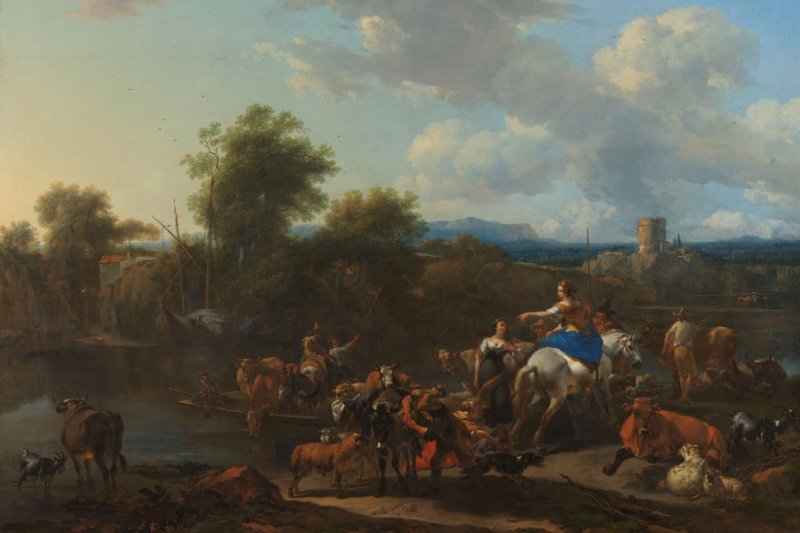
Researchers dated lead-based white paints used in several paintings -- including The Cattle Ferry, pictured, a 1655 painting by Nicolaes Pietersz Berchem -- to more closely determine the dates and locations of their creation. Image courtesy of Rijksmuseum Netherlands
Dec. 1 (UPI) -- A new isotope analysis of 77 paintings created by 27 Dutch artists has revealed subtle differences in a common white pigment that are directly tied to supply routes altered by historical conflicts, researchers said Wednesday.
With the new technique, researchers identified a change in supply of lead-based paint coinciding with the English Civil War in the mid-1640s and the end of the Eighty Years' War around the same time in what is now the Netherlands, Belgium and Luxembourg.
White paint used in the 77 paintings had higher variation of isotopic values, which are used to measure lead levels, between 1648 and 1680, the data showed.
These changes could be related to rising tensions and wars during this period, which impacted where lead was sourced for paint and other uses, the researchers wrote in an article published Wednesday by the journal Science Advances.
"We identify a significant change in the lead isotopic composition of lead white in the period 1642 to 1647 [and] this change coincided with some important socio-economic events that, most probably, altered the supply chain of lead," co-author Paolo D'Imporzano told UPI in an email.
"The differences in lead isotope ratios found in paintings made in different decades, especially before and after the transition, can ... help art researchers to answer some questions about debated paintings," said D'Imporzano, a research associate at Vrije University in Amsterdam.
The English Civil War, a series of conflicts fought between 1642 and 1651, was a battle between people who supported the establishment of a republic and those who favored the monarchy as the head of state.
The Eighty Years' War, or Dutch War of Independence, was a revolt within regions of present-day Netherlands, Belgium and Luxembourg against Philip II of Spain.
Both conflicts led to rising tensions throughout Europe and disrupted the flow of goods across the continent, according to historians.
Lead was used in the production of paint for centuries, and lead isotope analysis, which measures lead levels in paints, has been used to date works of art since the 1960s.
RELATED Two bronze statues might be attributed to Michelangelo
The technique has been used to examine differences in pigment production, establishing, for example, clear differences between lead white paint produced in northern and southern Europe.
For the analysis, D'Imporzano and his colleagues used paintings with known production dates to calibrate an international database used to help attribute and authenticate other works of art across Europe.
They tested lead levels in white paint samples from Dutch paintings created between 1588 and 1700, four of which dated to periods when the artists were known to have traveled outside the Netherlands.
Based on variations in lead isotope ratios for the paintings, there were two clusters centered around the periods from 1588 to 1642 and from 1648 to 1680.
The first group points to a lead supply chain used to produce lead white paint that remained constant for at least four decades, according to the researchers.
A transition to higher lead isotope ratio index values occurred, however, between 1642 and 1647, indicating a change in the source of the lead supply coinciding with the two conflicts, they said.
The wars, and the corresponding demand for weapons, led to a constant increase in the demand for lead during that period.
"England was the major lead producer and underwent an expansion in production leading to the exhaustion of parts of some mines and the opening of new ones," D'Imporzano said.
"These developments likely caused changes in the average lead isotope ratios of the product added to the market," he said.
Similarly, the conclusion of the Eighty Years' War, which led to the independence of the Dutch Republic, resulted in new trading agreements and, thus, potential changes in lead supplies, according to D'Imporzano.
In a case study in the Science Advances paper, the painting Cimon and Pero by Dutch artist Willem Drost, which was thought to have been created in Venice, in 1657, was found to have lead white with isotope values consistent with those found in the Netherlands around 1650.
"Performing lead isotope analysis on lead white now can help to better locate in time 17th Century Dutch paintings and this information can then be used to help to understand when a painting is made," D'Imporzano told UPI.
"By combining this information with other data, such as an artist's travels, it is possible to make more precise attributions" on paintings for which the artist is currently unknown, he said.
No comments:
Post a Comment